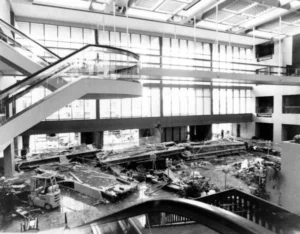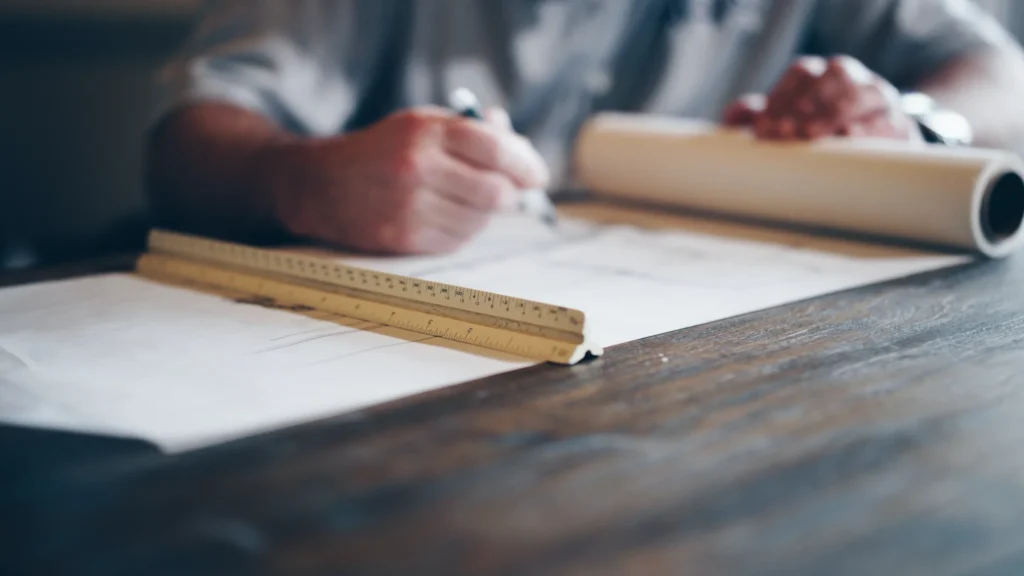By: Galloway Sr. Structural Project Engineer Roger Barringer, PE. Roger offers over 30 years of experience in structural design that includes engineering many diverse structures, from preliminary and schematic design through construction documents. He is also the longest tenured employee at Galloway and likes to joke that he “sets a new record every day.” We’re grateful for Roger’s insightful view on this event involving his profession.
July 17, 1981 marks the 40th anniversary of one of the great tragedies of this generation: the failure of the suspended walkways at the Hyatt Regency hotel in Kansas City. The significance of this event is, unfortunately, made more relevant in light of the recent tower collapse in Surfside, Florida.
 While the preliminary indication is that the Florida failure was not a design issue, caused instead by material failure and/or inadequate maintenance, the Hyatt failure was deemed to be a design issue, resulting directly from a lack of care by the lead structural engineer. And although a glaring example of negligence in engineering, it very much relates to all of us in this industry, and is why design professionals must be reminded of it.
While the preliminary indication is that the Florida failure was not a design issue, caused instead by material failure and/or inadequate maintenance, the Hyatt failure was deemed to be a design issue, resulting directly from a lack of care by the lead structural engineer. And although a glaring example of negligence in engineering, it very much relates to all of us in this industry, and is why design professionals must be reminded of it.
The Hyatt project was not insignificant. At the time it opened it was the tallest building in Kansas City. The main tower was 40 stories with over 700 rooms and topped by a revolving restaurant. A 4-story conference center was connected to the tower by a large atrium. It was a $50 million showpiece for the city, constructed on a fast-track with final CDs issued well after construction began.
Three walkways crossed the atrium, suspended from the roof structure by long steel rods. The walkways were a comparatively minor element of the project, and a relatively simple design. Two of the walkways failed during a popular Friday night dance party. Ultimately, the fault was found to be a very simple, but vitally important connection that was reconfigured in haste by the structural PM during the shop drawing review process. The final connection revision was never checked by the engineer: what appeared to be a straightforward design change essentially doubled the load on the connection, which the engineer overlooked at the time. The connection was destined to fail, and 114 people died because of it.
Of the many things that can be learned from this tragedy, perhaps the most relevant is the quality review process. Some main points are summarized below.
 And some takeaways…
And some takeaways…
The rod connection was a simple, insignificant detail on a relatively minor and uncomplicated segment of a very complex project. By its very simplicity, the PM was inclined to set aside this part of the design to deal with bigger, perhaps more pressing issues. It is the design team’s responsibility to recognize critical elements in a design, and give these elements the attention they are due.
The structural project manager was only 32 years old, and yet was tasked with overseeing the structural design of an enormous project. It is impossible to tell how a more seasoned professional would have acted in this circumstance, but ultimately it can be said that value of experience in the design process cannot be discounted.
Although 40 years ago, the lessons from this event are just as relevant today, if not more so. With technology so deeply integrated into the design process, much more than it was back then, one is inclined to complete projects more expeditiously than ever, and may lose sight of what is important in design. Technology is a fantastic tool, but engineers must not let it overshadow the human element of design.
For engineers, the disaster holds special significance. We must always remember that while our actions better the lives of the public, our misconduct risks those same lives. We can do no less than to take this lesson into our hearts and minds and live up to the expectations of the public.
Robynn Andracsek, P.E.,
Engineering News Record, December 2015
The most dramatic failures have occurred in a climate of overconfidence and carelessness, and the least we can learn from those incidents is to be more vigilant. Accidents and near accidents remain our surest reminders that engineering is a human endeavor that takes place in the context of other human endeavors, including calculated risk and celebration. None of the sane among us willfully wishes to place fellow human beings in imminent danger but we sometimes minimize or forget what dangers lurk among our technological creations. The surest way for us to be vigilant is to be aware of past mistakes…”
Henry Petroskii
To Engineer is Human
With our Full-Spectrum Approach to projects, our teams are extremely knowledgeable of how their discipline-specific design fits into the project holistically, and use their experience to ca
Contact Us